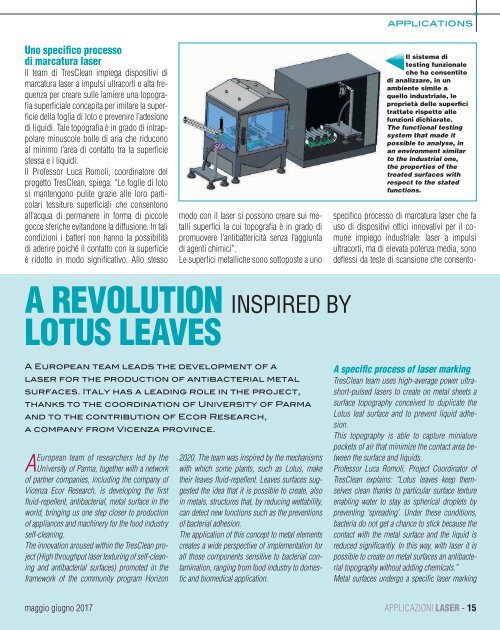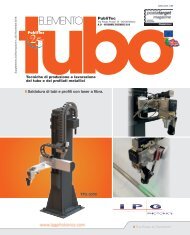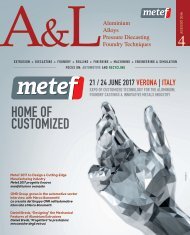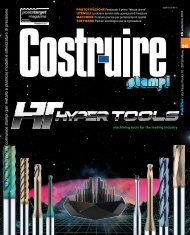Sfogliabile_Applicazioni_Laser_maggio_57
You also want an ePaper? Increase the reach of your titles
YUMPU automatically turns print PDFs into web optimized ePapers that Google loves.
applications<br />
Uno specifico processo<br />
di marcatura laser<br />
Il team di TresClean impiega dispositivi di<br />
marcatura laser a impulsi ultracorti e alta frequenza<br />
per creare sulle lamiere una topografia<br />
superficiale concepita per imitare la superficie<br />
della foglia di loto e prevenire l’adesione<br />
di liquidi. Tale topografia è in grado di intrappolare<br />
minuscole bolle di aria che riducono<br />
al minimo l’area di contatto tra la superficie<br />
stessa e i liquidi.<br />
Il Professor Luca Romoli, coordinatore del<br />
progetto TresClean, spiega: “Le foglie di loto<br />
si mantengono pulite grazie alle loro particolari<br />
tessiture superficiali che consentono<br />
all’acqua di permanere in forma di piccole<br />
gocce sferiche evitandone la diffusione. In tali<br />
condizioni i batteri non hanno la possibilità<br />
di aderire poiché il contatto con la superficie<br />
è ridotto in modo significativo. Allo stesso<br />
modo con il laser si possono creare sui metalli<br />
superfici la cui topografia è in grado di<br />
promuovere l’antibattericità senza l’aggiunta<br />
di agenti chimici”.<br />
Le superfici metalliche sono sottoposte a uno<br />
Il sistema di<br />
testing funzionale<br />
che ha consentito<br />
di analizzare, in un<br />
ambiente simile a<br />
quello industriale, le<br />
proprietà delle superfici<br />
trattate rispetto alle<br />
funzioni dichiarate.<br />
The functional testing<br />
system that made it<br />
possible to analyse, in<br />
an environment similar<br />
to the industrial one,<br />
the properties of the<br />
treated surfaces with<br />
respect to the stated<br />
functions.<br />
specifico processo di marcatura laser che fa<br />
uso di dispositivi ottici innovativi per il comune<br />
impiego industriale: laser a impulsi<br />
ultracorti, ma di elevata potenza media, sono<br />
deflessi da teste di scansione che consento-<br />
A REVOLUTION INSPIRED BY<br />
LOTUS LEAVES<br />
A European team leads the development of a<br />
laser for the production of antibacterial metal<br />
surfaces. Italy has a leading role in the project,<br />
thanks to the coordination of University of Parma<br />
and to the contribution of Ecor Research,<br />
a company from Vicenza province.<br />
AEuropean team of researchers led by the<br />
University of Parma, together with a network<br />
of partner companies, including the company of<br />
Vicenza Ecor Research, is developing the first<br />
fluid-repellent, antibacterial, metal surface in the<br />
world, bringing us one step closer to production<br />
of appliances and machinery for the food industry<br />
self-cleaning.<br />
The innovation aroused within the TresClean project<br />
(High throughput laser texturing of self-cleaning<br />
and antibacterial surfaces) promoted in the<br />
framework of the community program Horizon<br />
2020. The team was inspired by the mechanisms<br />
with which some plants, such as Lotus, make<br />
their leaves fluid-repellent. Leaves surfaces suggested<br />
the idea that it is possible to create, also<br />
in metals, structures that, by reducing wettability,<br />
can detect new functions such as the preventions<br />
of bacterial adhesion.<br />
The application of this concept to metal elements<br />
creates a wide perspective of implementation for<br />
all those components sensitive to bacterial contamination,<br />
ranging from food industry to domestic<br />
and biomedical application.<br />
A specific process of laser marking<br />
TresClean team uses high-average power ultrashort-pulsed<br />
lasers to create on metal sheets a<br />
surface topography conceived to duplicate the<br />
Lotus leaf surface and to prevent liquid adhesion.<br />
This topography is able to capture miniature<br />
pockets of air that minimize the contact area between<br />
the surface and liquids.<br />
Professor Luca Romoli, Project Coordinator of<br />
TresClean explains: “Lotus leaves keep themselves<br />
clean thanks to particular surface texture<br />
enabling water to stay as spherical droplets by<br />
preventing ‘spreading’. Under these conditions,<br />
bacteria do not get a chance to stick because the<br />
contact with the metal surface and the liquid is<br />
reduced significantly. In this way, with laser it is<br />
possible to create on metal surfaces an antibacterial<br />
topography without adding chemicals.”<br />
Metal surfaces undergo a specific laser marking<br />
<strong>maggio</strong> giugno 2017<br />
APPLICAZIONI LASER - 15





